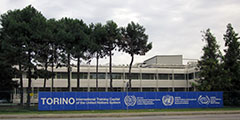Theory and practice of nonviolence can be learned, practiced and spread.
The Peace Lab-Museum, the first one in Italy, was established on September 20th 2008, closely following an international congress on the international peace museum network, and stemming from a local conscientious objector to military spending who had already had a congress arranged back in 1985 on nonviolent popular defense and local territorial authorities.
The buildings around belonged to the district mental hospital compound up to about 1973, when the Torino District signed it off (within the frame of a nationwide dismantling of lunatic asylums). These premises were thereafter appointed with time to other uses; among them, a Resistance Museum is now housed here, hosting as well the Peace Lab-Museum.
Its references have been drawn from a teaching by Johan Galtung, peace scholar awarded with a number of acknowledgments incl. the Right Livelihood Award (alternative Peace Nobel Prize) in 1987, and founder of Transcend international in 1993. In his address to the UN General Assembly on the 2007 International Nonviolence Day – Oct. 2nd, Gandhi’s birthday – he listed following five lessons he drew from Gandhi’s successful nonviolent liberation struggle against British colonialism:
1. Never shy away from dialogue
2. Never be afraid of conflict: it is an opportunity rather than a danger
3. Learn history lest you are bound to repeat it
4. Figure out a future (make it visible) lest you never reach it
5. While you fight occupation, tidy up your home as well!
The museum pathway is articulated in the following 5 spaces:
1) (VIDEO) where some film clippings about violence and nonviolent struggles are shown;
2) (LISTENING) where the emotions raised by that footage can be floated;
3) (CONTENTS) where Galtung’s 5 items are presented through a few objects;
4) (LAB) where the opportunity of working out the 5 items is offered, by taking them into one’s personal experience and mulling them over with some peace researchers who have expressed insights about them
5) (INFORMATION) where assistance to go on is given, by offering references of already active fellow bodies within reach, as well as a bibliography and website listing in order to make contacts and further explore the presented issues.







 20 minutes by bus 33 Collegno direction
20 minutes by bus 33 Collegno direction






